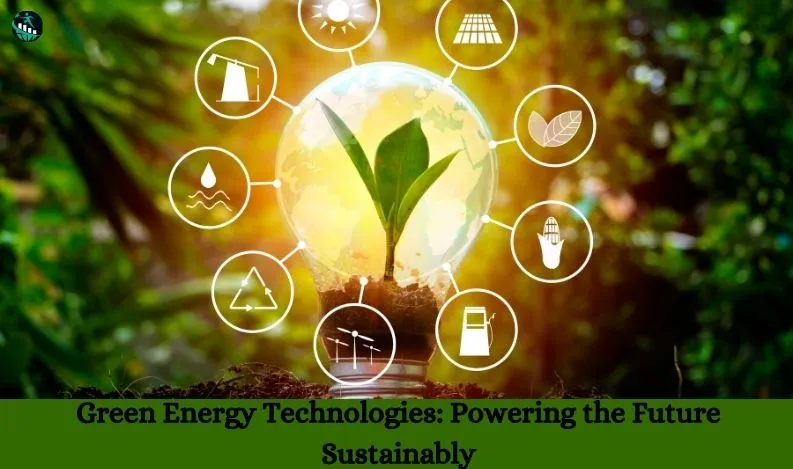
Green Energy Technologies: Powering the Future Sustainably
In the face of escalating environmental crises and the urgent need to halt climate change, humanity stands at a crossroads. The path we choose now, particularly in how we generate and consume energy, will significantly shape the planet's future. Green energy technologies offer a beacon of hope, promising a sustainable, cleaner future powered by the forces of nature rather than the polluting fossil fuels of the past. This blog delves deep into the world of sustainable energy, exploring the innovations and strategies that are key to powering the future sustainably.
Introduction: A Paradigm Shift in Energy Production
The global consensus on the necessity of transitioning to sustainable living practices has never been clearer. As the deleterious effects of climate change become increasingly undeniable, the shift toward renewable energy sources emerges as a critical step in mitigating environmental damage. The allure of green energy technologies lies not just in their potential to reduce greenhouse gas emissions but also in their ability to harmonize energy production with the planet's natural rhythms. This transition is multifaceted, involving not only the adoption of renewable resources like wind, solar, and hydro but also a profound transformation in societal attitudes towards energy consumption and environmental stewardship.
Solar Energy: Illuminating the Path Forward
Solar energy, with its promise of harnessing the boundless power of the sun, stands as a cornerstone of renewable energy strategies. The journey from sunlight to electricity has seen remarkable advancements in photovoltaic (PV) technology, significantly enhancing efficiency while reducing costs. Innovative approaches, such as perovskite solar cells and bifacial panels, offer the potential for even greater efficiencies and versatility in solar applications. Moreover, the concept of solar energy is expanding beyond the confines of large-scale farms and rooftop installations. Technologies like transparent solar panels are pioneering ways to integrate photovoltaic materials into windows, vehicles, and even clothing, turning everyday surfaces into renewable energy sources.
Wind Energy: Harnessing the Winds of Change
Wind energy represents one of the most rapidly expanding sectors of the green energy revolution. Modern wind turbines, towering giants of innovation, capture the kinetic energy of wind, converting it into clean electricity. Technological advancements have not only increased the efficiency and capacity of these turbines but also expanded their viability to offshore locations, where wind speeds are higher and more consistent. Floating wind farms, a nascent yet promising development, aim to overcome the depth limitations of traditional offshore turbines, unlocking the vast potential of deep-sea winds. These advancements signify a future where wind energy could feasibly supply a significant portion of global electricity demands.
Water Power: The Renaissance of Hydropower and Beyond
Hydropower, a veteran among renewable energy sources, is experiencing a renaissance through technological and ecological innovation. The shift towards small-scale, low-impact hydroelectric projects demonstrates a commitment to generating energy while preserving natural waterways and ecosystems. Concurrently, the exploration of marine energy sources, such as tidal and wave energy, is gaining momentum. These technologies, which convert the energy of tides and waves into electricity, offer promising solutions for coastal regions, combining consistent power generation with minimal environmental footprint.
Geothermal Energy: Tapping the Earth's Inner Heat
Geothermal energy harnesses the immense heat from beneath the Earth's crust, offering a reliable, constant energy source. Recent breakthroughs in drilling technologies and the development of enhanced geothermal systems (EGS) have broadened the potential for geothermal energy far beyond natural hotspots. These innovations allow for the extraction of geothermal heat from a wider range of geographical locations, promising a significant expansion of geothermal energy's role in the renewable energy landscape.
The Road Ahead: Navigating Challenges and Seizing Opportunities
The path to a future powered by green energy is laden with challenges, from technological hurdles like energy storage and grid integration to economic and policy barriers. Yet, the transition to renewable energy also presents unparalleled opportunities for innovation, economic development, and environmental restoration. Investing in green technologies not only propels us towards a sustainable future but also stimulates job creation in new industries, fosters energy independence, and positions us to meet the environmental challenges of the 21st century head-on.
Conclusion: A Collective Journey Towards Sustainability
The shift towards green energy technologies is more than a technical challenge; it's a collective journey towards a sustainable future. As we harness the power of the sun, wind, water, and Earth, we must also cultivate a culture of sustainability that permeates every aspect of our lives. By embracing these technologies and the changes they entail, we can forge a future that respects our planet's delicate balance, ensuring a livable, thriving Earth for future generations. The time for action is now, and together, we can power our world sustainably, embracing the green energy revolution as the cornerstone of our environmental legacy.
Also Read:-



Recent Comments: